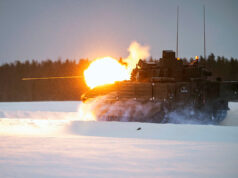In a landmark agreement, Germany and the United Kingdom have announced their collaboration on the next phase of development for advanced armour-piercing tank ammunition.
The Enhanced Kinetic Energy (EKE) round is set to significantly boost the armies’ ability to counter evolving enemy threats.
UK National Armaments Director, Andy Start, and his German counterpart, Vice Admiral Carsten Stawitzki, met at the Honourable Artillery Company in London to sign a Statement of Intent to work together on the EKE round. The advanced armour-piercing ammunition is expected to play a pivotal role in both nations’ defence strategies.
The ongoing qualification process confirms that the new munition adheres to all legal and regulatory standards. Officials from both countries are currently discussing the establishment of a joint programme this year, with the EKE ammunition slated for use on the Challenger 3 Main Battle Tank and German Leopard 2 tank.
Shared Work for Shared Benefits
The collaboration between the UK and Germany is anticipated to create a sustainable industrial capacity for both nations’ industries, sustaining jobs across the UK and supporting the UK Prime Minister’s priority to grow the economy.
UK Defence Secretary, Ben Wallace, emphasised the benefits of the joint programme, stating, “We’re very pleased to work with Germany on this programme, helping equip our respective Armed Forces with a crucial battle-winning capability. The standardised ammunition will not only benefit battlefield collaboration with many of our NATO allies, but has important export potential for UK and German defence industry partners.”
Improved Interoperability and Expanded Cooperation
The EKE rounds will be fired from the L55A1 turret on Challenger 3 and Leopard 2 Main Battle Tanks, supporting interoperability with NATO allies. This agreement follows both countries announcing the gifting of a squadron of their respective Main Battle Tanks to support Ukraine in its fight to counter Russia’s illegal invasion.
DEU State Secretary for FMOD, Benedict Zimmer, highlighted the strong partnership between the two nations, stating, “The programme for 120mm EKE tank ammunition once again proves that the United Kingdom and Germany remain to co-operate as very close partners and friends.”
Under the terms of the new agreement, Germany and the UK will remain open to additional nations joining the cooperation or becoming export recipients, while continuing discussions on potential collaboration for other types of 120mm tank ammunition.













There was much speculation that the combination of the L55 120mm smoothbore with the US DU round would be possible/give us the best capability in the world.
(The Abrams can’t take the longer barrel as it unbalances the turret, so the US has continued with DU to retain capability.)
Does this mean that the CR3 will be using (one presumes) a non-DU round? Or are the Germans shifting their position on its use?
Well I would guess it means moving away from DU to something better.
Also suggests a renewed interest in tanks. Joint venture there as well?
There is the Franco/German MBT project so it would probably be a case of the UK joining that. If we think we only need 148 tanks now would it be worth it? I don’t know.
Not really that projects progress is glacial! Basically it is a Leclec turret on a Leopard chassis🙄
Yep, probably right and if it’s anything like some of the other projects…🙃
The Leo2/Leclerc hybrid ( E-MBT ) and the future MGCS project are not exclusively the same thing.
No bother👍
We have observor status on that project.
The politicians think we only need 148 CR3 tanks – more of a reason to join a collaborative programme for the tank after CR3 – it would not be worth building such a small number on our own.
Unfortunately it’s the politicians make the decisions based as we know on pound notes and I can’t see them running another project up at the moment. The way things are going we’ll be lucky to see existing programmes implemented
Maybe they got the rights to use Nintendium.
The strongest material on earth.
Perhaps the US should look to Japan? Their new tank has a short 120mm/44 barrel, but thanks to clever steelmaking, it can take a high pressure round that outshoots the 55 barrels of Germany.
Purely speculating here but I’ve read that at very high speeds DU will shatter and be outperformed by WHA.
So perhaps the plan is to create a super high velocity, and high pressure, WHA round?
A non – DU Round is the objective yes.
Interesting – I always thought a good upgrade for M1 was a L55. Your comment on the turret explains why they missed out on this upgrade. Not sure why they did not go for a upgraded turret like CH3.
The new round will be great. I should imagine it will be a tungsten alloy, I cannot imagine that the Germans will go for DU on environmental grounds. Perhaps the UK can have a DU one for domestic use… EKE DU.
The net fallout from the Ukraine war in regard to MBTs will be very interesting. Advanced protection systems must be high on the list of observations either the lack of them or their performance where fitted. The Russian tanks have shown a remarkable lack of additional armour that actually works. Some vehicles are taken out with small sky bombs from drones? As for closer cooperation with German tank developments, it can only lead to improved MBT performance. I’d like to see remote MBT concepts developed in the near future as this will be one area of considerable expansion in the years ahead.
Unfortunately so many collaborative MBT projects have failed, but we must surely collaborate for the tank after CR3 due to such a small fleet size.
We developed a remotely operated MBT at RARDE (Chertsey) in the late 80s.
Please forgive my ignorance and ineptitude in the finer details(in particular the shortened descriptions of systems)but I try to take a close interest to the best of my ability in the current situation/development of military equipment,not least since the Russian maniac decided he’d have a bit of a jolly into Ukraine.
I’m now 53yrs old and remember years ago the amount of investment/advance in all things military.
That said I’ve also seen,and been told by serving family members,of the paucity of investment since the supposed end of the cold War.
For example my brother in law fought in 03 and 06 in Iraq.
03 issued with khaki for desert warfare and boots whose soles melted and fell off.
06 same issue with boots and the list goes on.
So in conclusion I hope that you all won’t mind me occasionally asking questions,that for you will seem ridiculously simple
Regards
The statement sort of infers that the Army is looking at replacing the concept of the depleted uranium (DU) round as used by the current Challenger 2, with a tungsten round. It kind of makes sense to team up with the country that developed the Rh120/L55 gun to also develop the ammunition. But there are other countries that produce armour piercing fin stabilized discarding sabot (APFSDS) rounds that conform to STANAG 4385.
These are the US, France, Israel and South Korea. The US produce the M829 series with the latest being the A4 version. Which nearly matches the muzzle velocity of the DM73 round even though its fired from the shorter L44 barrel. Whilst both France and South Korea produce a tungsten based APFSDS round that has a greater muzzle velocity than the newer DM73, due to better propellent properties.
Fired from the same gun at the same muzzle velocity, a depleted uranium dart will have more penetrative performance than a tungsten based one. On the face of it this would seem surprising, as tungsten is denser than DU. But it is more to do with the mechanical properties than the chemical. As everyone knows DU is pyrophoric, which means that fine dust particles (which are poisonous), such as those produced when DU is machined, may catch fire spontaneously in air. Which also happens when the dart penetrates armour.
But more crucially is DU’s ability to self-sharpen when passing through armour. This is where the tip continuously peels away its hotter outer skin coating leaving a cooler sharper material behind it. Thereby helping it maintain its ability to penetrate armour for longer. Whereas tungsten flattens and gets blunter, which makes it harder to keep penetrating. If this is the case, why don’t Germany produce a dart using DU? The Green Party in Germany holds a massive vote, so anything with a nuclear tag will not get through Parliament.
There have been recent developments in dart design to narrow the capability gap between DU and tungsten. With increasing dart diameters and lengths, to two part darts with a leading sacrificial piece, primarily to defeat the latest ERA, but also helps forge a hole for the main dart. Along with research into telescopic darts, where they increase their overall length after leaving the barrel. Which means there is more material available to pass through the armour.
But you can apply all these techniques to DU and it will still be better performance wise. So it begs the question of why?
The obvious answer is political, either:
Is that tungsten /titanium alloy to replace DU ?
The APFSDS darts that say they are made from Tungsten are usually made from an alloy. A lot do contain Titanium, along with nickel, colbalt even steel. The chemical make-up of the dart is a closely guarded secret.